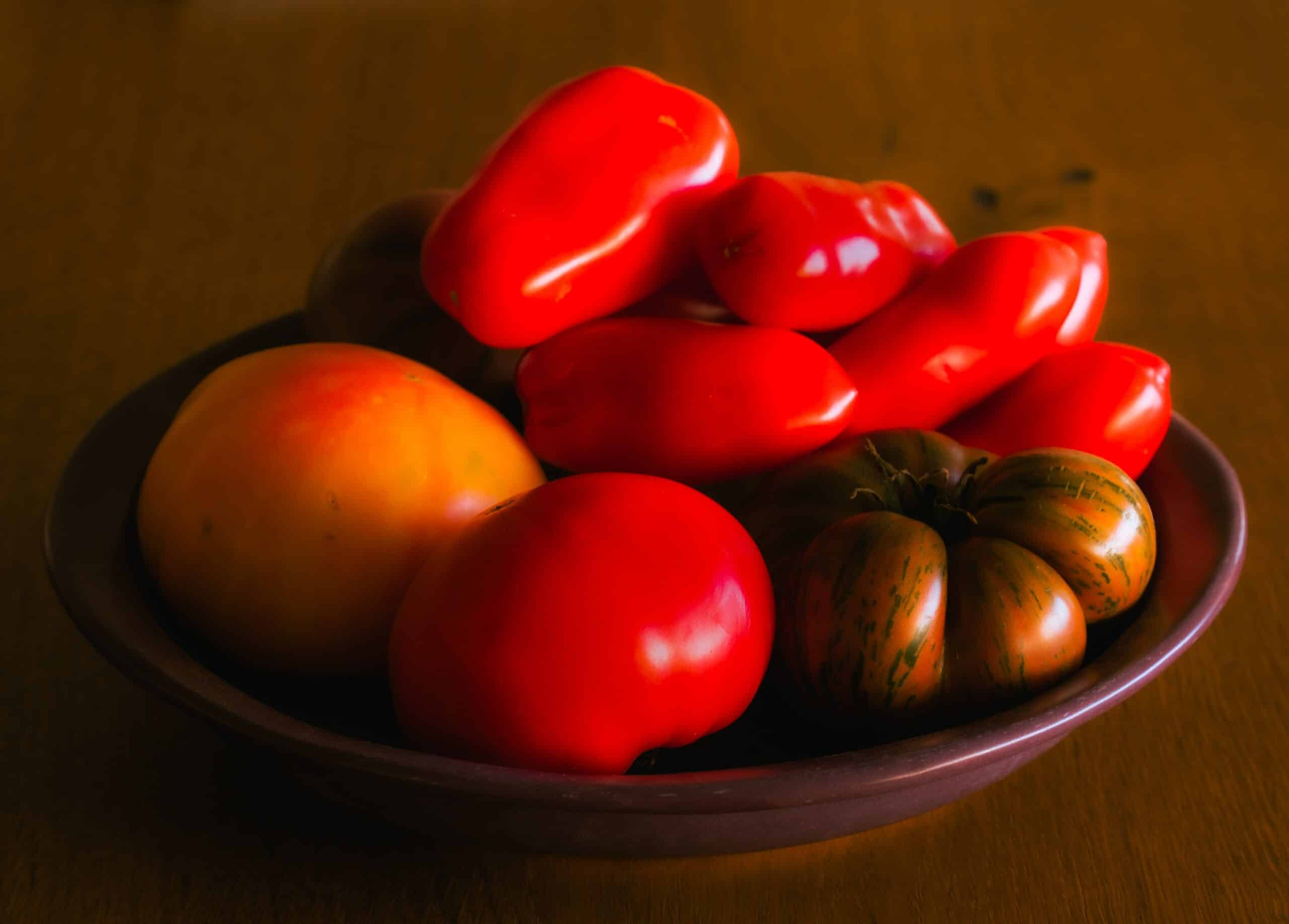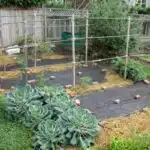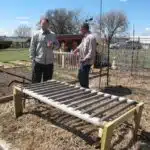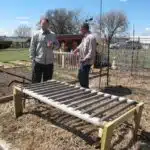If you’re looking for an easy-to-grow vegetable to add to your garden, Roma tomatoes are the way to go. Not only are they delicious, but they are also highly nutritious and can be used in a variety of dishes. Growing Roma tomatoes is fun and easy, especially if you know a few key tips when it comes to planting, growing, and caring for them. In this article, we’ll provide an overview of how to plant, grow, and care for Roma tomatoes so that you can enjoy a plentiful harvest all season long!
Roma tomatoes have become increasingly popular in recent years due to their rich flavor and versatility. They are low in calories yet high in fiber and vitamins A & C – making them perfect for any meal or snack. Plus, their size makes them ideal for slicing into salads or sandwiches. With just a bit of knowledge about how to plant and care for them properly, you can easily grow these tasty vegetables at home with minimal effort!
Growing Roma tomatoes is also great for helping others – not only will you be able to share the deliciousness with friends and family but you’ll also be serving up a nutritious snack that’s free from preservatives or additives. So if you’re looking for an easy way to make a positive impact on your community while learning something new in the process – this article is just what you need!
What Are Roma Tomatoes?
Roma tomatoes are a time-honoured, succulent variety of tomato that have been making their mark on the culinary world for centuries. As an anachronism, they have long been seen as a symbol of abundance, health and joy – something that has been appreciated from the ancient Greeks to modern day cooks. Growing roma tomatoes can bring you all these benefits and more; when done correctly, you can enjoy fresh, delicious tomatoes throughout the growing season.
To get started with cultivating your own roma tomatoes, it’s important to understand what makes them unique. These determinate plants produce medium-sized tomatoes with a firm flesh. The strong taste makes them great for cooking and adding to salads too. Roma tomatoes are also known for being low in acidity and very flavorful – perfect for homemade sauces or pickling!
Once you know what type of tomato you’re dealing with, it’s time to start planning how you’re going to grow them. Consider where they will be planted in your garden or allotment; ideally somewhere sunny and sheltered from wind. If space is limited then containers work just as well but need regular watering and fertilizer during the season. With careful attention to soil quality and moisture levels, your roma tomatoes should thrive!
With the right preparation, growing roma tomatoes can be incredibly rewarding. Not only will you get a bumper crop of delicious fruit but there’s also the satisfaction of having created something wonderful with your own two hands. All that’s left now is to find the ideal spot in your garden or allotment – let’s dive into where exactly these tasty morsels should call home!
Where To Plant Roma Tomatoes
The theory that planting roma tomatoes in the right location can make a huge difference to their growth and production is certainly true. Any gardener who has ever tried growing them will know that finding the ideal spot for them is key. But where should you plant roma tomatoes? Let’s find out.
First, it’s important to understand that roma tomatoes prefer full sun with at least six hours of direct light per day. They should be planted in an area which gets plenty of air circulation and away from any other plants or trees that might create shade. The soil should be well-drained and amended with compost before planting. Planting tomatoes too deep can lead to root rot, so make sure they are planted no more than two inches deep in the soil.
When it comes to choosing pots, containers, or raised beds for growing roma tomatoes, it’s important to ensure they have enough room for their roots to spread out. Containers need to be at least 12 inches deep and wide, while raised beds should be 8–12 inches high depending on the type of tomato being grown. Make sure there is adequate drainage holes in both containers and raised beds too! If you’re planting multiple tomato plants next to each other, remember to leave around 18–24 inches between them for adequate air circulation and space for the plants to grow into.
Considering all these factors when deciding where to plant your roma tomatoes will help ensure a healthy crop of delicious fruit come harvest time!
When To Plant Roma Tomatoes
It’s time to get your hands dirty and sink your shovel into the soil – it’s time to plant your Roma tomatoes! Planting Roma tomatoes is an exciting endeavor, but it pays off in spades when you bite into that first juicy, home-grown tomato. Like any big undertaking, it can be a bit daunting to know where exactly to start. But don’t worry – we’ll cover everything you need to know about getting started with planting your Rome tomatoes. Let’s dive in!
The timing of when you plant your Roma tomatoes is key. Planting too early can lead to stunted growth or even frost damage. Planting too late may leave you without the rich harvest you hoped for. So, strike while the iron is hot and get these babies into the ground at just the right moment! Here are five tips for getting the timing just right:
- Look up your region’s frost-free date so you know exactly when it’s safe to start planting.
- Start seeds indoors 6-8 weeks before this date so they can be hardy enough for outdoor conditions by then.
- If purchasing plants from a nursery, wait until after this date so they’re not exposed to cold temperatures before settling in their new home.
- Consider setting up a cold frame or greenhouse if there is still a risk of frost but you still want an early start on harvesting season.
- Make sure nighttime temperatures stay above 50F (10C).
Getting the timing right ensures that your Roma tomatoes will have plenty of time to grow and thrive before winter sets in again. With some patience, planning and effort, you’ll soon be enjoying mouth-watering homegrown tomatoes like never before! Now that we’ve gone over when to plant them, let’s move on to how they should actually be planted…
How To Plant Roma Tomatoes
In the garden of life, cultivating a successful crop of Roma tomatoes can be compared to a rewarding journey for any home gardener. Not only does it require planning and attention to detail, but also dedication and perseverance. To get started on this exciting adventure, here are the steps necessary for planting Roma tomatoes:
First, it is important to wait until after the last frost before planting your Roma tomatoes outdoors. Then, you should choose an area in your garden that receives at least six hours of direct sunlight each day. Once you have established the perfect spot for your tomatoes to thrive, here are some tips to help you with planting:
• Dig a hole twice as wide and deep as the root ball • Place the tomato in the hole and fill dirt around it • Water thoroughly once finished planting • Afterward, mulch around base of plant with straw or wood chips
With these simple steps in place, your Roma tomato plants will soon be on their way to success. Now that they are planted, it is time to move onto another essential part of their growth – soil requirements.
Soil Requirements For Growing Roma Tomatoes
Cultivating a crop of Roma tomatoes is an exciting task for any gardener. But in order to reap the rewards that come from such a venture, one must be attentive to the soil requirements necessary for them to thrive.
Firstly, it is important that the planting area receives plenty of sunlight throughout the day, as most tomato plants need at least six hours of direct sunlight in order to flourish. The best type of soil for growing Roma tomatoes is well-drained and contains plenty of organic matter such as compost or aged manure. For those with heavier clay soils, it can help to dig in some sand or peat moss to improve drainage. Additionally, having your soil tested can provide useful information on nutrient levels and pH balance so you can adjust accordingly if needed.
When preparing beds for planting, mix in an all-purpose fertilizer into the top inch or two of soil and work it into the ground until fully blended. It is also beneficial to add lime or wood ash if your soil’s pH level is below 6.0 – this will help create an environment where essential nutrients are more readily available for your tomatoes. Properly amending your soil before planting can make a huge difference in success with this delicious vegetable!
Next up: discovering what temperature requirements are necessary for growing Roma tomatoes.
Temperature Requirements For Growing Roma Tomatoes
Gardening is one of the most rewarding activities out there. It’s a great way to connect with nature and take on a project that can bring you joy and satisfaction. When it comes to tomatoes, Roma tomatoes are an especially delicious variety that can really bring your garden to life. Temperature requirements are essential for growing these delicious fruits.
In order for Roma tomatoes to thrive, they need temperatures between 65-75 degrees Fahrenheit during the day, and 50-55 degrees Fahrenheit at night. These values help ensure that the plant’s growth isn’t stunted or affected by extreme temperature fluctuations. The plants should also receive about 6 hours of direct sunlight a day in order to produce enough fruit for harvest. If you live in an area with warmer climates, make sure you take extra care when watering your Roma tomato plants as too much water can lead to diseases and rot.
To ensure optimal growing conditions, check on your tomato plants regularly and look out for signs of distress or wilting due to heat stress or lack of water. Also be sure to keep an eye out for pests like aphids which can cause damage to the leaves and stems if not addressed quickly enough. With proper care and monitoring, your Roma tomatoes will be able to reach their full potential!
Now that we’ve discussed temperature requirements, its time to turn our attention towards water requirements for growing Roma tomatoes.
Water Requirements For Growing Roma Tomatoes
Growing Roma tomatoes can be a rewarding experience for any home gardener. Take Martha, for example. She was unsure of what to expect when she first planted her tomatoes, but by following these steps and paying attention to the water requirements, she’s now harvesting delicious fruit from her garden! Water is an important factor in growing Roma tomatoes, so it’s essential to understand the needs of your plants.
Roma tomatoes need consistent and even watering throughout the growing season. It’s best to water the soil deeply, allowing it to become moistened all the way through rather than sprinkle it with just enough to wet the top layer. This will help your plants build strong roots that go deep into the soil and will also reduce problems like blossom end rot or cracking due to dryness. Additionally, try not to get any leaves wet as this can lead to disease development. A good time to water would be early morning or late evening when there is less sunlight and evaporation rate is lower.
It’s also important not to over-water your Roma tomatoes; this can cause problems such as root rot or fungal diseases from stagnant water in the soil. The best way to tell if your plants are getting enough water is by checking out the color of their leaves; if they’re looking limp or yellowing, then you may need to increase watering frequency or amount per session. Additionally, you should avoid splashing soil onto leaves while watering as this could spread illnesses like blight or mildew.
While providing adequate amounts of water for your Roma tomato plants is important for success in the garden, fertilizing and feeding them correctly is equally vital in order for them to thrive.
Fertilizing And Feeding Roma Tomatoes
Growing Roma tomatoes can be a rewarding experience and an excellent way to bring fresh produce to your table. To ensure your tomatoes thrive, it’s important to know how to fertilize and feed them correctly. In this section, we’ll explore the best ways to fertilize and feed your Roma tomatoes.
Fertilizing is essential for growing healthy and flavorful Roma tomatoes:
Fertilizer:
Use a balanced fertilizer such as 10-10-10 or similar, once every two weeks when the plants are actively growing.
Use a fertilizer that is low in nitrogen but high in phosphorus and potassium. This will help encourage fruit production instead of leaf growth.
If desired, you can use an organic fertilizer like compost tea or fish emulsion.
Feeding:
During the blooming period, you should supplement with a high phosphorus liquid tomato food every 7-10 days for maximum fruit production.
If your soil is very rich in nutrients, feeding may not be necessary. However, if you aren’t able to test the soil regularly then it’s best to err on the side of caution and provide supplemental feeding anyway.
Mulching:
Mulching with straw or another type of organic material around your tomato plants will help keep weeds down and retain moisture in the soil so your plants don’t dry out too quickly.
By giving your Roma tomatoes the right amount of fertilizer and food, you can ensure they receive all the necessary nutrients they need for healthy growth and delicious harvest! With proper care and attention, these hardy tomatoes will reward you with a bountiful crop that’s sure to impress friends and family alike. Now that we’ve covered fertilizing and feeding roma tomatoes, let’s look at pruning them for optimal growth!
Pruning Roma Tomatoes
Pruning roma tomatoes is like a sculptor perfecting their masterpiece. It is an essential part of the growing process that helps create healthier plants and bigger yields. To get the most out of your tomato crop, pruning should be done regularly and correctly.
Begin by removing all side shoots or suckers that grow between the main stem and the leaves. These are easy to spot as they will have small yellow flowers which will later turn into fruit if left unpruned. Removing these side shoots encourages more energy to go towards producing larger fruits on the main stem. However, it is important not to over-prune, so leave one or two side shoots per leaf cluster if possible.
In addition to removing side shoots, pruning can also help improve air circulation around the plant. This helps reduce humidity which in turn minimizes the risk of diseases such as blight from occurring. Prune any lower branches that are touching the ground or other plants in order to keep air flowing freely around them.
To ensure you get an abundant harvest of big, juicy tomatoes this season, make sure you pay regular attention to your pruning routine and don’t forget about those essential bits of maintenance! By following these simple steps you can reap the rewards of healthy, productive roma tomato plants with plenty of delicious fruits for your enjoyment.
Supporting Roma Tomatoes
Supporting Roma tomatoes is essential for a successful harvest. For example, take the case of Sarah, a first-time grower of Roma tomatoes. She has just finished planting her seeds and is now ready to support them as they grow. Here are a few ways to do that:
Water regularly: Sarah needs to water her plants every 3-4 days so the soil remains moist but not soggy.
Feed with fertilizer: To help her plants thrive, Sarah should use a liquid fertilizer every two weeks or use organic compost at least once during the growing season.
Provide adequate sunlight: Since Roma tomatoes love the sun, Sarah should make sure that each plant receives at least six hours of direct sunlight each day.
Use stakes or cages: To keep her plants upright and provide extra support from strong winds, Sarah can stake them or put cages around them for extra stability.
These are just some of the ways that Sarah can support her Roma tomato plants as they grow and mature into delicious, juicy fruits later in the season. With proper care and attention, she can look forward to enjoying a plentiful harvest! Taking proactive steps on pest and disease control is also important for keeping her crop healthy and thriving throughout the summer months.
Pest And Disease Control For Roma Tomatoes
A lush, fruitful garden of Roma tomatoes can be a sight for sore eyes. To make sure your tomatoes reach their full potential, pest and disease control is key. Fortunately, with the right know-how and some dedication, you can protect your plants from common issues.
The first step to successful pest and disease control is prevention. Make sure your tomato plants are in an area that’s not too wet or too dry; both of these conditions can encourage pests and diseases. Additionally, keep your plants spaced far enough apart to give them room to breathe – overcrowding can cause problems as well.
If you do find yourself dealing with pests or diseases in your garden, there are organic methods you can use to deal with the issue. Start by carefully removing any affected leaves or fruits from the plant and dispose of them away from the garden. You can also try spraying a mixture of water and neem oil onto the plants to ward off pests, or use biological treatments such as Bacillus thuringiensis (Bt) to help eliminate caterpillars or other insects that may be eating away at your tomatoes. Finally, always make sure to clean up debris around the garden regularly so as not to attract more unwanted guests!
With these steps in mind, you’ll be well on your way towards having a healthy harvest of ripe Roma tomatoes!
Harvesting Roma Tomatoes
Harvesting Roma tomatoes is an exciting time for gardeners. It’s estimated that in the US alone, 1.5 million households grow tomatoes for their own consumption. When it comes to harvesting Roma tomatoes, timing is key. They should be picked when they are firm and fully red for the sweetest flavor. Here are some tips for harvesting your homegrown Roma tomatoes:
• Inspect the tomato – Check each fruit for color and firmness before picking. • Pick carefully – Use gloves to avoid damaging the skin of the tomato, as this could cause it to rot prematurely. • Handle with care – Don’t squeeze or drop the tomatoes as this can damage them and reduce their shelf life.
When harvesting your Roma tomatoes, it’s important to pick them at the right time to ensure they are ripe and ready to eat or store. If you wait too long, they may become overripe and mushy, but if you pick them too early, they won’t be as sweet or flavorful. Additionally, make sure you don’t pick any diseased or damaged fruit as this could spread disease to other plants in your garden.
Now that you’ve harvested your Roma tomatoes, it’s time to think about storing them properly so they last longer and retain their flavor and texture.
Storing Roma Tomatoes
Storing roma tomatoes is like putting away your holiday decorations. It’s the final step needed to cap off the successful growth of your beloved plants. Here are four steps to keep in mind when storing your roma tomatoes:
Make sure the tomatoes have sufficiently ripened before picking them from the vine. Any green tomatoes should be left on the plant to continue ripening.
Gently remove any remaining leaves, stems, and debris while handling the tomatoes with care so they don’t get damaged or bruised.
Store tomatoes at room temperature in a cool, dry place that isn’t exposed to direct sunlight; this will help them last longer and preserve their flavor.
You can store individual tomatoes in a single layer on a baking sheet lined with parchment paper in order to prevent them from sticking together and spoiling quickly.
Following these simple tips can help you maximize your tomato harvest and make sure you have plenty of flavorful fruits available all season long! As an added bonus, storing your roma tomatoes correctly will also make it easier for you to lend a helping hand whenever friends or family need some tasty produce for their meal prep. Now let’s answer some of those common questions about growing roma tomatoes so you can share your newfound knowledge!
Common Questions About Growing Roma Tomatoes
Growing Roma tomatoes can be a rewarding experience. But before you get to harvesting and enjoying your own homegrown tomatoes, there are a few things to consider. Common questions come up when growing Roma tomatoes, so let’s take a look at what the answers can be.
One of the most common questions is about how much space is needed when planting these tomatoes. Generally, Roma tomatoes need about two feet of space between each plant for optimal growth and health. Another question people often have is if these plants need support such as cages or stakes. The answer is generally yes, some sort of structure should be used to hold up the tomato vines as they grow.
The last common question that arises around growing Roma tomatoes is about fertilizing them. Fertilizing helps provide essential nutrients for healthy growth and production of fruit, so it’s important to use a fertilizer specific to tomatoes such as an organic fertilizer or compost tea every two weeks throughout the growing season.
Being informed on these topics will help ensure you have a successful growing season! Now that you know the basics, understanding troubleshooting common problems with Roma tomatoes will help you even further.
Troubleshooting Common Problems With Roma Tomatoes
Having troubles growing your Roma tomatoes? Don’t worry, you’re not alone! A lot of people have issues when it comes to planting, growing and caring for their Roma tomatoes. In this article, we’ll take a look at some of the common problems that people face when tending to their crops.
One issue that crops up is incorrect soil pH levels. It’s important to maintain an optimal pH level in order to keep your tomatoes healthy and strong. If the soil isn’t acidic enough, this can lead to nutrient deficiencies or diseases like blossom end rot. To avoid this problem, test your soil regularly and adjust its pH levels accordingly.
A second issue is improper watering. Overwatering can cause root rot, while underwatering can lead to poor growth and flavorless fruit. Make sure you check your soil moisture by sticking your finger about two inches into the ground before giving it any water. This will help you determine if it needs more hydration or not.
Finally, pests can also be a problem for Roma tomato growers. Keep an eye out for bugs like aphids, mites, hornworms, and other insects that may try to feed on your plants’ leaves and fruits. If needed, use natural insecticides such as neem oil or horticultural oils to get rid of these pests without harming the environment or your plants’ health.
Frequently Asked Questions
How Long Do Roma Tomatoes Take To Mature?
Growing Roma tomatoes is a rewarding experience, but it can also be a bit of a challenge. Take the case of my neighbor, who was eager to enjoy the taste of fresh Roma tomatoes from his own garden. After carefully planting and tending to his plants, he was thrilled when they began to produce fruit. But he soon realized that he had misjudged how long it would take for them to mature.
When it comes to how long it takes for Roma tomatoes to mature, there are some important points to consider. Generally speaking, these tomatoes will reach maturity in about 70-80 days after planting, depending on the variety and growing conditions. To ensure their growth is as successful as possible, here are five tips:
• Make sure your tomato plants get plenty of sunlight and water—this will help them grow faster and more efficiently. • Provide adequate support for the plants so they don’t become weighed down by their heavy fruits. • Don’t let the soil dry out completely; keep it consistently moist but not soggy. • Keep an eye out for pests or disease and take necessary steps if you spot any issues. • Use fertilizer or compost regularly throughout the growing season to ensure your plants have all the nutrients they need.
With proper care and attention, you can ensure that your Roma tomatoes reach their full potential in terms of both flavor and yield! If you follow these tips, your companion tomato plants will be producing ripe fruits in no time at all – just like my neighbor’s did!
How Much Space Should Be Left Between Plants When Planting Roma Tomatoes?
When planting Roma tomatoes, you might be wondering how much space should be left between plants. While it’s tempting to squeeze in as many plants as possible and maximize your harvest, leaving enough space between each plant is essential for healthy growth. With the right knowledge and care, you can ensure that your Roma tomatoes thrive!
First things first: The recommended spacing between two tomato plants is 36 inches apart from the center of each plant. This allows enough room for each tomato to develop properly and prevents overcrowding of the vine leaves and stems. At the same time, you’ll need to make sure that the soil is adequately fertilized – a soil rich in nutrients will ensure your tomatoes get the best start possible.
If you’re short on space or would like to maximize your harvest, there are also some alternative methods of planting Roma tomatoes. For example, you could use a trellis system which provides extra support for the vines and encourages better air circulation around the plants. Additionally, by pruning away lower branches and using stakes or cages to support taller plants, you can save on ground space while still allowing your tomatoes plenty of room to grow.
Here are some key takeaways to bear in mind when planting Roma tomatoes: • Provide adequate spacing between plants (36 inches apart). • Fertilize soil for strong root development. • Consider alternative methods such as trellising or pruning for close-spaced areas. The success of any gardening project lies in proper planning and careful execution – with these tips in mind, you’ll be ready to create an amazing tomato patch!
What Is The Best Fertilizer For Roma Tomatoes?
Growing Roma tomatoes can be a rewarding experience and they are easy to care for when you know the right techniques. One key factor in ensuring that your plants thrive is using the correct fertilizer. But which one is best?
When it comes to fertilizing Roma tomatoes, it’s important to use a fertilizer that’s specially formulated for vegetables. These fertilizers contain higher levels of nitrogen, phosphorus, and potassium; these nutrients ensure that your tomato plants get the nourishment they need to produce flavorful fruit. Look for a fertilizer labeled as 5-10-10 or 8-16-16; these ratios provide adequate amounts of nitrogen and potassium while also providing other trace elements.
It’s also important to consider how often you’ll need to fertilize your Roma tomatoes. Generally speaking, most vegetable plants require fertilization every four weeks during their growing season. If your soil is particularly nutrient poor, you may need to fertilize more frequently throughout the season. Pay attention to the appearance of your tomato plants; if they look yellow or start wilting, you may need to apply more fertilizer sooner rather than later.
The best way to ensure healthy tomato plants is by using the right fertilizer at regular intervals throughout their growing season. With careful selection and timely application, you can reap a bountiful harvest of delicious Roma tomatoes!
How Long Do Roma Tomatoes Stay Fresh After Harvesting?
The thought of plump, juicy Roma tomatoes ripe for the picking is enough to tantalize even the most discerning palate. With a little care and attention, you can savor these delicious fruits of your labor long after they have been harvested. But how long do Roma tomatoes stay fresh after harvesting?
When it comes to harvesting Roma tomatoes, timing is key. The best time to harvest your Roma tomatoes is when they are deep red in color and feel slightly soft when gently squeezed. Once plucked from the vine, you can expect them to stay fresh for up to two weeks if stored correctly. The ideal storage temperature is between 55 and 60 degrees Fahrenheit with high humidity; refrigeration is not recommended as this will cause the tomatoes to lose their flavor and firmness.
To get the most out of your harvest, it’s important to use them promptly. Enjoy them raw or cooked within 5-7 days for peak flavor and texture. If you have harvested more than you can use right away, consider preserving them by freezing or canning so that you can enjoy them at a later date. With just a little bit of effort, you can savor the taste of summer all year round!
Are Roma Tomatoes Susceptible To Any Specific Diseases Or Pests?
Roma tomatoes have been a popular choice for gardeners since the 1950s due to their robust flavor and history of being easy to grow. Unfortunately, like most vegetables, they are susceptible to disease and pests that can damage or even kill the plants if not addressed quickly. Knowing which issues to look out for and how to handle them can help keep your tomato harvest safe and successful.
Take for example one gardener from California who had an unfortunate experience with nematodes. She was growing roma tomatoes in her garden when she noticed that the leaves were turning yellow and the plant’s growth had slowed down significantly. After some research, she discovered that her soil was infested with nematodes, tiny worms that feed on tomato roots. With careful treatment using beneficial nematode products, she was able to get rid of the pests without damaging the ecosystem of her garden.
There are many other potential diseases and pests that may threaten roma tomato plants including:
- Fusarium Wilt: Causes wilting of leaves, yellowing of foliage and eventual death of entire plants
- Late Blight: Causes brown spots on leaves that eventually spread to stems and fruit
- Tomato Hornworms: Large green caterpillars that feed on foliage as well as fruits
Fortunately, these issues can all be managed with regular monitoring and proper treatment including pruning off affected areas, applying fungicides or insecticides when necessary, or removing affected parts completely. Keeping your soil healthy through composting or mulching will also help reduce the chances of any serious problems occurring in your garden. By taking proactive steps like these you can ensure a safe harvest!
Conclusion
When it comes to growing Roma tomatoes, a little effort can yield great results. With the right knowledge and care, these delicious tomatoes can be enjoyed for weeks or even months. From choosing the right fertilizer, to planting and spacing correctly, to harvesting at the right time, any gardener has the potential to become an expert in growing Roma tomatoes.
The rewards of growing Roma tomatoes are immense. Not only is it a satisfying accomplishment to see them grow from small seedlings into thick vines with clusters of fruit but the taste of fresh-picked Roma tomatoes cannot be beaten. A perfectly ripe tomato picked straight from the vine is like biting into a piece of summer sunshine – sweet, juicy and bursting with flavor!
Gardening is not only a fun activity but also a great way to provide yourself with healthy and delicious vegetables that you can enjoy all year round. With proper planning and care, any gardener can have success in growing Roma tomatoes – it’s nothing short of miraculous!





























